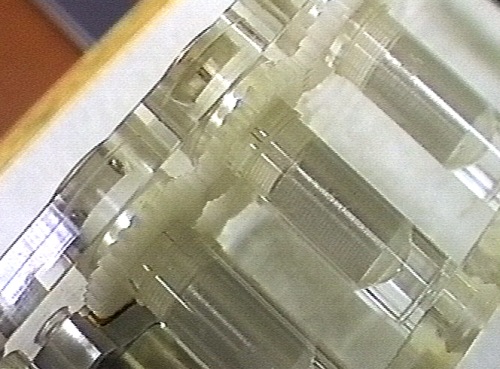- Dozent/in: Monika Schäfer
- Dozent/in: Heike Jüngst
- Dozent/in: Silvia Roe
- Dozent/in: Hans Latz
- Dozent/in: Silvia Roe
- Dozent/in: Hans Latz
- Dozent/in: Silvia Roe

- Dozent/in: Andrea Kreiner-Wegener
- Dozent/in: Silvia Roe
- Dozent/in: Beate Wassermann

- Dozent/in: Silvia Roe
- Dozent/in: Beate Wassermann

- Dozent/in: Silvia Roe
- Dozent/in: Beate Wassermann
- Dozent/in: Mariana Echeverry-Caballero
- Dozent/in: Silvia Roe

INFO BOARD
Table of Contents:
AWPF Fundamentals of Biomedical Engineering
Lecturer: Dr. rer. nat. Reiner Schnettler
Medical technology:
- What is medical technology?
- Meaning of MT based on the development of medical technology?
- Differentiation between: "biological technology and biologically conditioned technology" Def. technology.
- Development phases of MT.
- Medical technology in the field of tension between technology and medicine.
- Sciences with the prefix bio:
◦ Biology
◦ Biotechnology
◦ Biophysics
◦ Biomedical engineering or biomedical engineering sciences.
Medical technology and life extension State of the art research:
- Artificial organs
- Importance of model systems in biology and medicine.
- The importance of the axolotl in regenerative medicine
- Automated production of bone, cartilage and skin substitutes
- Organs from the 3D printer
- Necessary scaffolds for cell culture of organ tissues
- The importance of electrospinning technology
- Ghost organs
- Problems of organ cultivation
- 5 basic tissues (elementary tissues) are to be mastered
- Stem cells, adult or embryonic?
- Importance of immune defense
- Technical (bionic organ substitutes)
Hemodialysis as an example of a bionic organ replacement:
- What does the original
- the smallest functional subunit of the kidney
- Requirements for a bionic solution
- Possible solutions to
Medical technology in space:
- Electrically induced cell fusion (biomembranes under µ x g - conditions).
- The principle of operation: dielectrophoresis, the biological membrane as a capacitor, reversible and irreversible electrical breakdown
- The influence of homogeneous and inhomogeneous electric fields
- The effect of alternating voltage and direct voltage
- Experimental setup for electrically induced cell fusion
- The steps of electrically induced cell fusion
- The voltage-time diagram of electrofusion
- Possible applications
Importance of measurement in medical technology:
- Importance of measurement in medical technology
- Measurement error, systematic and random measurement error, examples
- Closed loop measurement systems
- The concept of measurand
- Combinations of different measuring methods, sense and purpose
- Tasks of measurement technology in medical technology
Evaluation of reliability of medical examinations:
- Table of true negative, true positive, false negative and false positive results
- diagnostic specificity
- diagnostic non-specificity
- diagnostic sensitivity
- diagnostic non-sensitivity
biosignals:
- biosignals
- electrical biosignals
- The special characteristics of electrical biosignals
- Overview of human biosignals
- Classification of biosignals according to their physical qualities
- Biosensors for the detection of biosignals
Proteins and enzymes as the basis of biosensors:
- What are proteins?
- Properties of proteins
- Building blocks of proteins
- The hydrochloric acid pepsin experiment
- Biogenic amino acids
- The importance of the spatial structure of proteins
- Primary, random coil, secondary, tertiary and quaternary structure of proteins
- Enzyme proteins
Enzymes and enzyme kinetics:
- The enzyme as a biocatalyst
- Classification of enzymes, 6 main classes
- Applications for enzymes, in the cell, in medicine, in biotechnology
- Temperature and pH optimum for enzymes
- Terminology of enzymes
- Reaction kinetics of enzymes as a simple way to characterize enzymes
- General chemical reaction equation for enzymes
- Dissociation constant of the enzyme-substrate complex
- Michaelis-Menten equation
- Michelis constant
- Lineweaver-Burk equation
- V-[S] diagram of an enzyme catalyzed reaction
- Micheleis-Menten kinetics of an enzyme-catalyzed reaction
- substrate analogues
- competitive inhibition
- non-competitive inhibition
- allosteric inhibition, and how to distinguish between them
- Enzymes and the position of chemical equilibrium
- Methods for the determination of the Michaelis constant
The origin of electrical biosignals:
- Organigram of the eukaryote cell
- Fluid mosaic model of the cell membrane
- Components of the biolg. Membrane
- Thought experiment Origin of electrical biosignals
- What is needed? What are the initial conditions?
- The meaning of Stavermann's reflection coefficient
- Experiment to build up a membrane potential without Na+-K+-ATPase
- Calculation of the membrane potential approximately
- Calculation of the membrane potential more exactly
- Initial conditions, final conditions
- Experimental setup without Na+-K+-ATPase
- Calculation of the resting membrane potential
- Which ion determines the resting membrane potential to a first approximation?
- Nernst equation, Nernst factor, Goldmann equation, constant field equation
- How good is the Nernst equation, compared to the Goldmann equation?
- The electronic equivalent circuit of the biological membrane for the resting potential
- Assignment of the physiology to the components of the electronic equivalent circuit
- Calculation and simulation of the equivalent circuit
- Mathematical relationship between electrolytic permeability and membrane conductivity
Excitable membranes:
- Threshold potential, electrically gated ion channels.
- Structure of a motor neuron,
- Soma, dendrites, axon hillock, axon, terminal knob, synapse, Ranvier's lacing rings, Schwann's cells,
- Functions of dendrites,
- Functions of the axon,
- Experimental setup for measuring action potentials,
- Um-time diagram, Gm-time diagram,
- Conclusion for the modification of the electronic equivalent circuit of the resting potential.
- Origin of the AP at the neuron,
- locomotion of the action potential,
- Chain ladder model, where and when valid,
- Longitudinal or length constant,
- Relationship with axon diameter,
- anelectrotonus, and cathelectrotonus
- continuous and saltatory excitation conduction (excitation propagation),
- all-or-nothing law
- rheobase and chronaxy,
- refractory period, absolute and relative refractory period
- Receptors,
- pain and pressure receptors,
- torsion balance,
- frequency modulation of stimulus intensity,
- sensory nerve pathways, somatosensory cortical field of cerebral cortex,
- motor nerve pathways,
- somatomotor cortical field of cerebral cortex,
- Morphology of neurons,
- fine structure of synapses,
- Consideration of subsynaptic membrane and subsnyptic cleft,
- Postsynaptic membrane areas,
- Current valve function
- The influence of axon hills
The influence of axon hillock near and axon hillock far synapses,- relationship between morphines and endorphins
Chain ladder,
electrotonus,- Structure of the nervous system:
Electric and ligand-gated synapses,How does the AP cross the synaptic cleft, Transmitter vesicles, Transmitter firing, what events precede, receptor-gated ion channels excitatory, inhibitory receptor-gated ion channels Postsynaptic potentials, excitatory, inhibitory Relationship between transmitter firing and triggered AP number What prevents sustained excitation of ligand-gated synapses acetycholine, dopamine pharmacological significance of transmitter analogues atropine, curarerelationship between morphines and endorphins Structure of the nervous system:
- Central nervous system consisting of brain and spinal cord
- peripheral NS, and vegetative NS
- autonomic NS, voluntary NS
Muscle (The muscle as a chemo- thermo- mechanical
energy converter):
- Cell types
- Characterization of muscle cell types
- Action potentials of muscle cells especially cardiac muscle cells
- Extracellular potential measurement versus transmembrane potential measurement
- Electronic equivalent circuit of the cardiac muscle cell
- Tetanus, tetanisability, complete incomplete
- Motor end plate
- Structure and function of striated muscle
- Actin, myosin, myosin head, troponin, tropomyosin, myosin binding site, myosin filament, The role of calcium and magnesium, ATPase activity and myosin.
- Sarcomeres
- Contractile unit
- Molecular mechanism of muscle contraction
- Sliding - filament - mechanism
- The role of ATP
- Longitudinal tubules
- Transverse tubules
- Sarcoplasmic Reticulum
- Sarcolemma
- Types of contraction of the muscle
Fine structure of the myofibril:
- The tubular system (transverse and longitudinal tubules, Ca2+-storage)
- The sarcomere (structure of the smallest contractile subunit of the
skeletal muscle)
The molecular mechanism of muscle contraction (sliding filament hypothesis):
- Sliding filament mechanism
- The actin-myosin complex
- The role of ATP as energy supplier and softener (rigor mortis)
The muscular action potential:
- In smooth muscle
- Cardiac muscle
- In skeletal muscle
- Modified electronic equivalent circuit of the working myocardium
The motor endplate:
- Endplate potentials
The mechanical equivalent circuit of the muscle:
- Working diagram of the muscle
- Resting strain curve
- Isometric contractions
- Isotonic contractions
- auxotonic contractions (positive-, negative-)
- Tetanus (incomplete-,complete-)
The importance of pharmacologically active substances in neuro- and muscle physiology:
Cardiovascular system:
- Structure (two pumps)
- Relationship to the lungs and the body
- after birth
- Lungs in shunt
- Lungs in the main circuit
- Small circuit
- systemic circulation
- Arteries
- Veins
- Position of the heart in the body
- The pericardium
- Sliding fluid
- The heart as a hollow muscle
- Heart valves
- Aorta
- Valves and leaflets
- The working cycles of the heart
- The importance of the sympathetic and vagus nerves
- Resting ECG
- Assumptions underlying the ECG derivation according to Einthoven
- ECG lead forms: Einthoven, Wilson, Goldberger, Nehb
- Unipolar and bipolar lead forms
- Extremity lead
- Differential electrodes and indifferent electrodes
- Planes, which can be developed by the ECG
- frontal plane,-horicinal plane, saggital plane
- What information does the resting ECG provide?
- waves and stretches of the ECG recording
- Non-invasive determination of the anatomical cardiac axis
- The heart as a dipole
- Summation vector of the heart (summation vector)
- Cabrera circle
- Vector cardiography
- Electronic equivalent circuit for deriving biopotentials from the body surface
- Rythmus disturbances without alteration of the basic rhythm
- Rythmusst disturbances with change of the basic rhythm
- Extrsystoles
- Compensatory pause
- Estrasystoles in the area of the ventricles
- Interposed extrasystoles
- Five-point accupressure cardiac explosion technique zwinkernd
Ergospirometry as an example of a non-invasive procedure to determine the performance capacity and limitations of an organism:
- Assessment of performance capacity (cardiovascular, pulmonary function, and metabolism).
- Differential diagnosis of exercise intolerance
- Evaluation of therapeutic interventions
- Basis for training recommendations
- Basis for the evaluation of pension applications
- Components and basics of ergospirometry
- Performance of ergospirometry examinations
- Evaluation of ergospirometry examinations (9 field evaluation according to Wassermann)
- Dozent/in: Reiner Schnettler
- Dozent/in: Silvia Roe
- Dozent/in: Monika Waschik
This is the German for beginners course for exchange students.
The sessions will take place every Thursday, 10-11.30 am in room 5.2.05 in building 5, Ignaz-Schön-Straße 11 in Schweinfurt.
I look forward to meeting you!
- Dozent/in: Hanna Usbeck-Frei
- Dozent/in: Daniel Groß
- Dozent/in: Silvia Roe
- Dozent/in: Boris Bittner

- Dozent/in: Silvia Roe
- Dozent/in: Beate Wassermann

- Dozent/in: Silvia Roe
- Dozent/in: Beate Wassermann

- Dozent/in: Graeme Dunphy
- Dozent/in: Silvia Roe
- Dozent/in: Silvia Roe
- Dozent/in: Jutta Walther
- Dozent/in: István Akács
- Dozent/in: Silvia Roe
Japanisch A1a
Lerninhalt: ab Lektion 1 bis 6 von „Japanisch im Sauseschritt“
In diesem Kurs soll die Kommunikationsfähigkeit für alltägliche Situation geübt werden mit den Schwerpunkten Grundlage der Grammatik, Phonetik und Einführung in die japanischen Schrift, Hiragana. Grammatische Schwerpunkte sind: Verb-Endungen und Zeitformen von „desu“ und „-masu“, Kasuspartikel, Verwendungsvariationen mit Zahlen (Uhrzeiten, Datum, Währungen und Zähleinheitswörter), Höflichkeitsformen, usw.Japanisch A1a
Lerninhalt: ab Lektion 1 bis 6 von „Japanisch im Sauseschritt“
In diesem Kurs soll die Kommunikationsfähigkeit für alltägliche und berufliche Situationen geübt werden mit den Schwerpunkten Grundlage der Grammatik, Phonetik und Einführung in die japanischen Schrift, Hiragana. Grammatische Schwerpunkte sind: Verb-Endungen und Zeitformen von „desu“ und „-masu“, Kasuspartikel, Verwendungsvariationen mit Zahlen (Uhrzeiten, Datum, Währungen und Zähleinheitswörter), Höflichkeitsformen, usw.
- Dozent/in: Toyomi Iwawaki-Riebel
- Dozent/in: Silvia Roe
- Dozent/in: Silvan Renz
- Dozent/in: Silvia Roe
- Dozent/in: Uwe Dolata
- Dozent/in: Silvia Roe
- Dozent/in: Kilian Moritz
- Dozent/in: Silvia Roe



